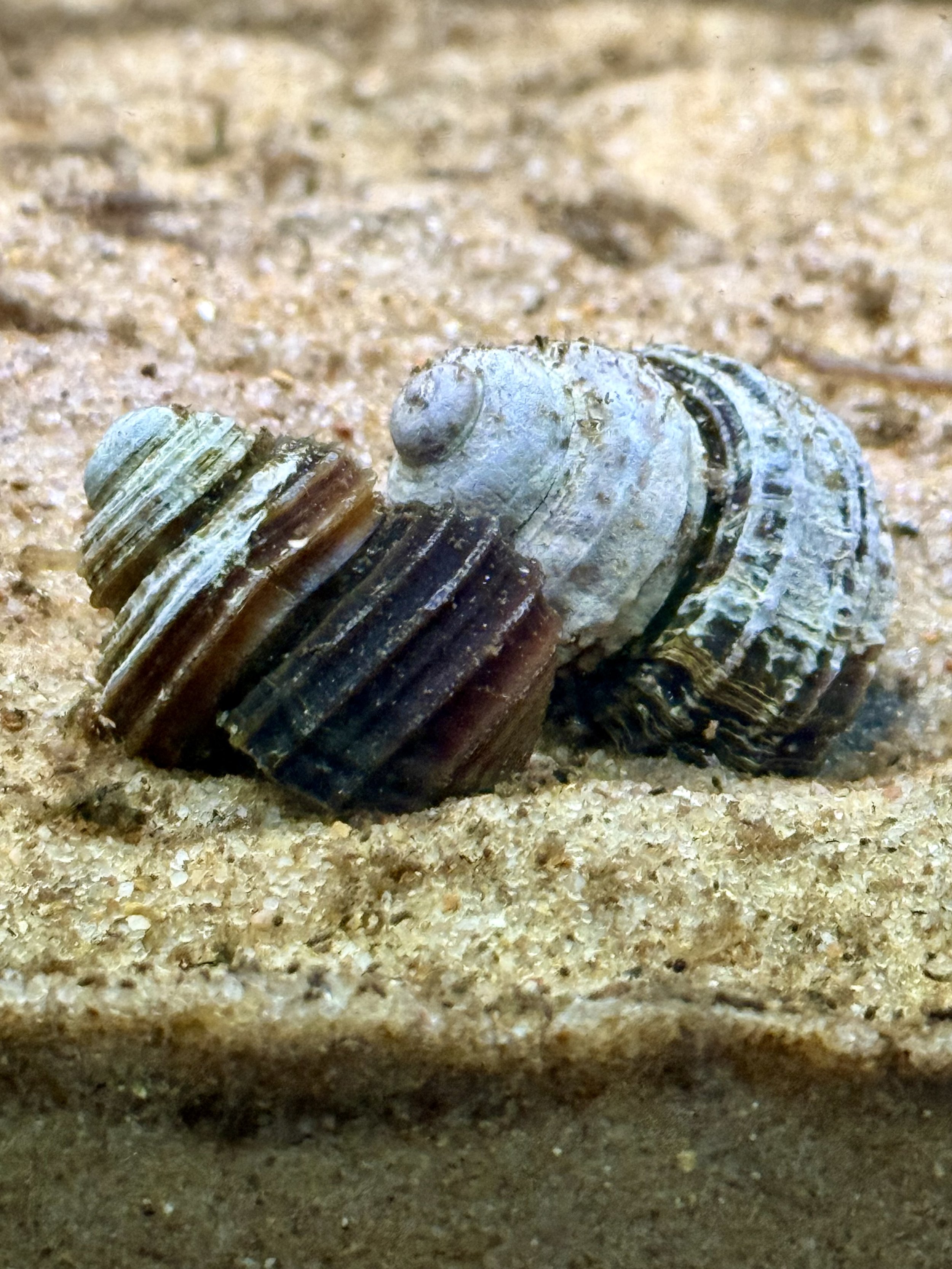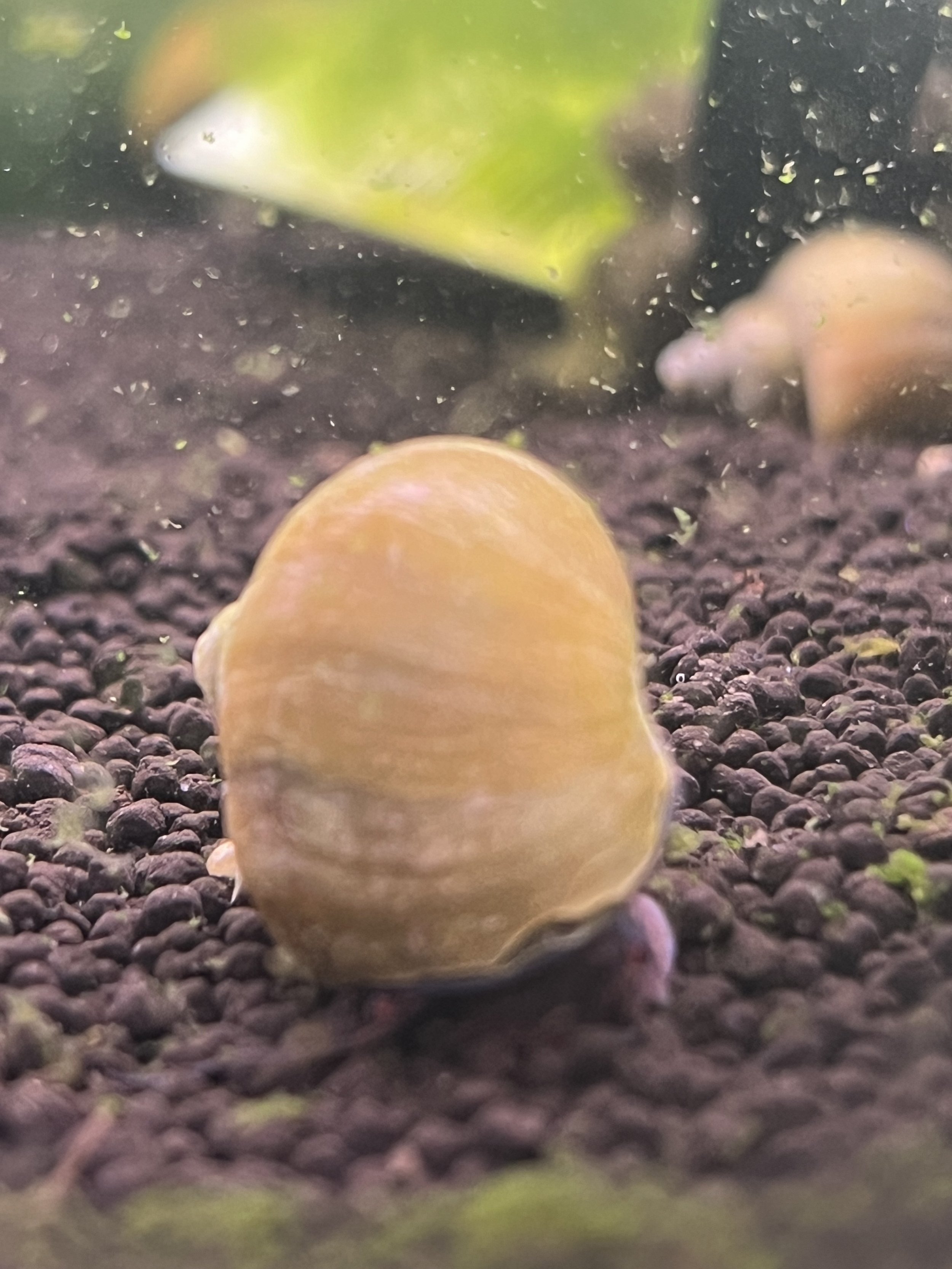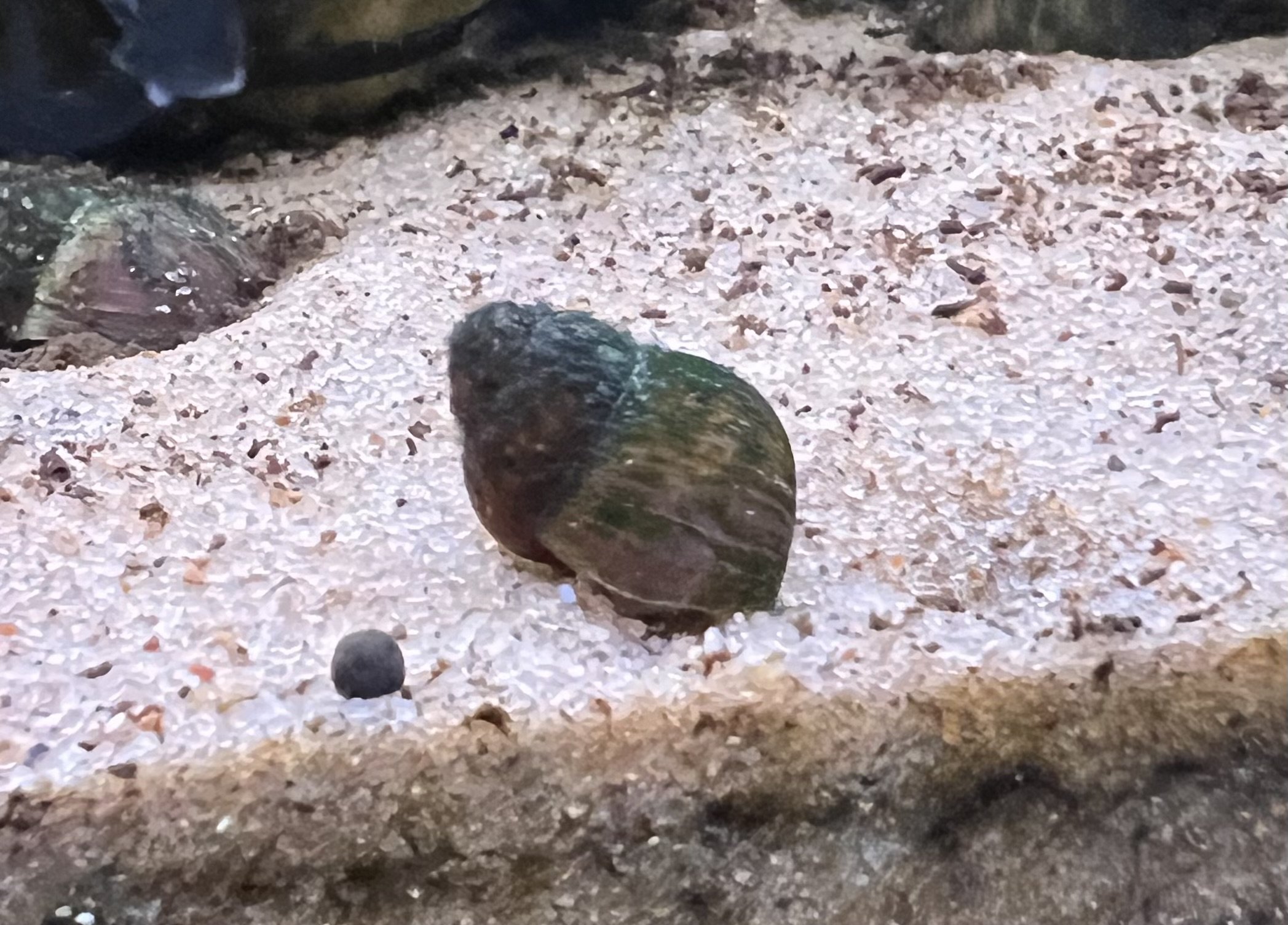 Image 1 of 3
Image 1 of 3

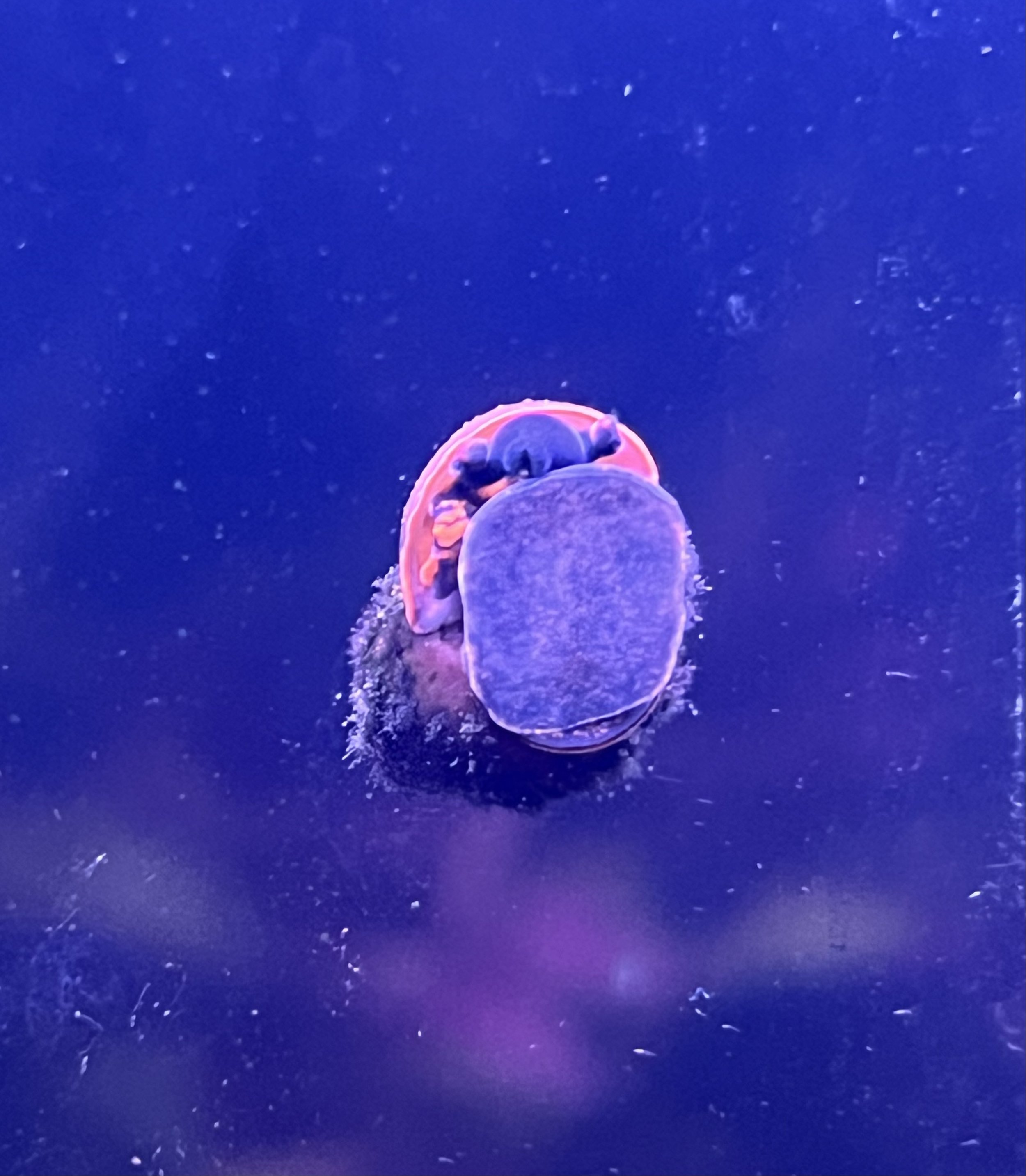 Image 2 of 3
Image 2 of 3

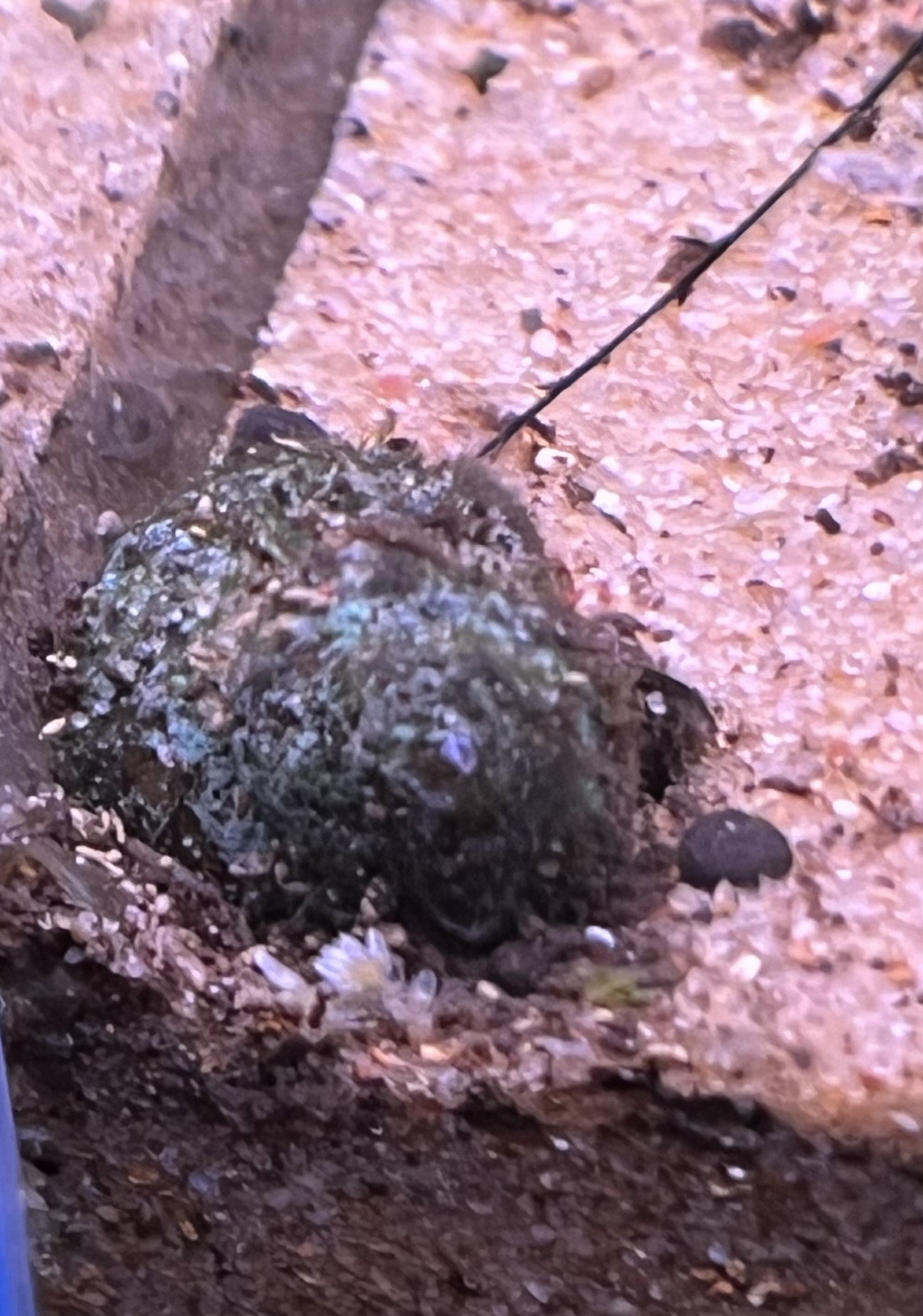 Image 3 of 3
Image 3 of 3




Papua Blueberry Snail
The Blueberry Snail, scientifically known as Viviparus sp., is a species of freshwater snail native to the rivers and lakes of Southeast Asia, particularly Papua New Guinea. This snail is often referred to by its common name due to its distinct bluish tint, which makes it stand out in aquarium setups. Belonging to the Viviparidae family, or river snails, it is known for its peaceful nature, hardy disposition, and ability to thrive in a variety of freshwater environments.
Physical Description:
The Blueberry Snail has a smooth, spiraled shell that can range in color from dark gray to blue or purple, with the bluish tint being the characteristic feature that gives it its name. The shell is thick and rounded, providing excellent protection from predators and environmental factors. Its smooth, glossy texture makes it an attractive addition to aquariums. Adult Blueberry Snails can reach up to 1.5 to 2 inches (4 to 5 centimeters) in size, making them a noticeable yet manageable addition to a tank.
Aquarium Care:
In an aquarium setting, Blueberry Snails are peaceful and non-aggressive, making them an ideal choice for community tanks with small fish and other peaceful invertebrates. These snails are natural scavengers and will spend much of their time grazing on biofilm, algae, and detritus, contributing to the overall cleanliness of the aquarium. While they can help control algae growth, they are not as efficient as some other snail species, so they are best considered part of a broader clean-up crew.
Water Parameters:
Blueberry Snails are hardy and adaptable, but they thrive best in slightly alkaline water with a pH range of 7.0 to 8.5. They prefer temperatures between 65 to 80°F (18 to 27°C), making them suitable for both tropical and temperate tanks. Hard water is essential for maintaining their shells, which require calcium to prevent erosion and degradation. In softer water environments, calcium supplements may be necessary to support shell health. Crushed coral or cuttlebone can be used to raise the calcium content in the tank.
Feeding:
Feeding Blueberry Snails is straightforward, as they are omnivores and opportunistic feeders. While they will naturally graze on algae and biofilm in the tank, their diet can be supplemented with sinking algae wafers, vegetable-based pellets, and blanched vegetables such as spinach, zucchini, or cucumber. These foods will ensure they receive the nutrients necessary for proper growth and shell maintenance.
Breeding:
Viviparus snails are livebearers, meaning they give birth to fully developed juvenile snails rather than laying eggs. This reproductive method makes them easier to manage, as they do not reproduce as rapidly as egg-laying snail species. However, it is still important to monitor their population in a well-maintained aquarium to avoid overpopulation.
Overall:
The Blueberry Snail (Viviparus sp.) is a hardy, attractive, and peaceful species that can be a great addition to freshwater aquariums. Their unique coloration, combined with their algae-eating and scavenging habits, make them both visually appealing and practical. With proper care, including attention to water hardness and a varied diet, these snails can thrive and contribute to the overall health and balance of the tank.
The Blueberry Snail, scientifically known as Viviparus sp., is a species of freshwater snail native to the rivers and lakes of Southeast Asia, particularly Papua New Guinea. This snail is often referred to by its common name due to its distinct bluish tint, which makes it stand out in aquarium setups. Belonging to the Viviparidae family, or river snails, it is known for its peaceful nature, hardy disposition, and ability to thrive in a variety of freshwater environments.
Physical Description:
The Blueberry Snail has a smooth, spiraled shell that can range in color from dark gray to blue or purple, with the bluish tint being the characteristic feature that gives it its name. The shell is thick and rounded, providing excellent protection from predators and environmental factors. Its smooth, glossy texture makes it an attractive addition to aquariums. Adult Blueberry Snails can reach up to 1.5 to 2 inches (4 to 5 centimeters) in size, making them a noticeable yet manageable addition to a tank.
Aquarium Care:
In an aquarium setting, Blueberry Snails are peaceful and non-aggressive, making them an ideal choice for community tanks with small fish and other peaceful invertebrates. These snails are natural scavengers and will spend much of their time grazing on biofilm, algae, and detritus, contributing to the overall cleanliness of the aquarium. While they can help control algae growth, they are not as efficient as some other snail species, so they are best considered part of a broader clean-up crew.
Water Parameters:
Blueberry Snails are hardy and adaptable, but they thrive best in slightly alkaline water with a pH range of 7.0 to 8.5. They prefer temperatures between 65 to 80°F (18 to 27°C), making them suitable for both tropical and temperate tanks. Hard water is essential for maintaining their shells, which require calcium to prevent erosion and degradation. In softer water environments, calcium supplements may be necessary to support shell health. Crushed coral or cuttlebone can be used to raise the calcium content in the tank.
Feeding:
Feeding Blueberry Snails is straightforward, as they are omnivores and opportunistic feeders. While they will naturally graze on algae and biofilm in the tank, their diet can be supplemented with sinking algae wafers, vegetable-based pellets, and blanched vegetables such as spinach, zucchini, or cucumber. These foods will ensure they receive the nutrients necessary for proper growth and shell maintenance.
Breeding:
Viviparus snails are livebearers, meaning they give birth to fully developed juvenile snails rather than laying eggs. This reproductive method makes them easier to manage, as they do not reproduce as rapidly as egg-laying snail species. However, it is still important to monitor their population in a well-maintained aquarium to avoid overpopulation.
Overall:
The Blueberry Snail (Viviparus sp.) is a hardy, attractive, and peaceful species that can be a great addition to freshwater aquariums. Their unique coloration, combined with their algae-eating and scavenging habits, make them both visually appealing and practical. With proper care, including attention to water hardness and a varied diet, these snails can thrive and contribute to the overall health and balance of the tank.
The Blueberry Snail, scientifically known as Viviparus sp., is a species of freshwater snail native to the rivers and lakes of Southeast Asia, particularly Papua New Guinea. This snail is often referred to by its common name due to its distinct bluish tint, which makes it stand out in aquarium setups. Belonging to the Viviparidae family, or river snails, it is known for its peaceful nature, hardy disposition, and ability to thrive in a variety of freshwater environments.
Physical Description:
The Blueberry Snail has a smooth, spiraled shell that can range in color from dark gray to blue or purple, with the bluish tint being the characteristic feature that gives it its name. The shell is thick and rounded, providing excellent protection from predators and environmental factors. Its smooth, glossy texture makes it an attractive addition to aquariums. Adult Blueberry Snails can reach up to 1.5 to 2 inches (4 to 5 centimeters) in size, making them a noticeable yet manageable addition to a tank.
Aquarium Care:
In an aquarium setting, Blueberry Snails are peaceful and non-aggressive, making them an ideal choice for community tanks with small fish and other peaceful invertebrates. These snails are natural scavengers and will spend much of their time grazing on biofilm, algae, and detritus, contributing to the overall cleanliness of the aquarium. While they can help control algae growth, they are not as efficient as some other snail species, so they are best considered part of a broader clean-up crew.
Water Parameters:
Blueberry Snails are hardy and adaptable, but they thrive best in slightly alkaline water with a pH range of 7.0 to 8.5. They prefer temperatures between 65 to 80°F (18 to 27°C), making them suitable for both tropical and temperate tanks. Hard water is essential for maintaining their shells, which require calcium to prevent erosion and degradation. In softer water environments, calcium supplements may be necessary to support shell health. Crushed coral or cuttlebone can be used to raise the calcium content in the tank.
Feeding:
Feeding Blueberry Snails is straightforward, as they are omnivores and opportunistic feeders. While they will naturally graze on algae and biofilm in the tank, their diet can be supplemented with sinking algae wafers, vegetable-based pellets, and blanched vegetables such as spinach, zucchini, or cucumber. These foods will ensure they receive the nutrients necessary for proper growth and shell maintenance.
Breeding:
Viviparus snails are livebearers, meaning they give birth to fully developed juvenile snails rather than laying eggs. This reproductive method makes them easier to manage, as they do not reproduce as rapidly as egg-laying snail species. However, it is still important to monitor their population in a well-maintained aquarium to avoid overpopulation.
Overall:
The Blueberry Snail (Viviparus sp.) is a hardy, attractive, and peaceful species that can be a great addition to freshwater aquariums. Their unique coloration, combined with their algae-eating and scavenging habits, make them both visually appealing and practical. With proper care, including attention to water hardness and a varied diet, these snails can thrive and contribute to the overall health and balance of the tank.

